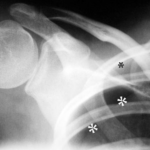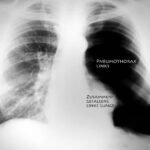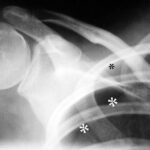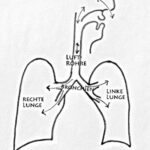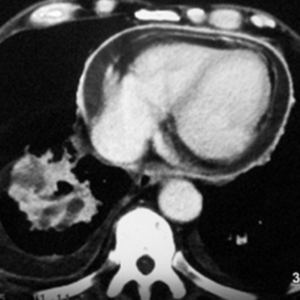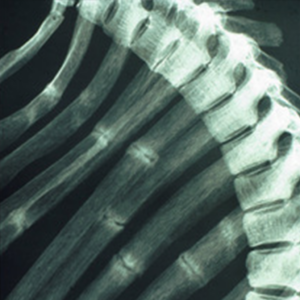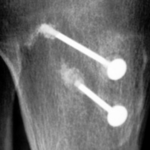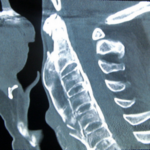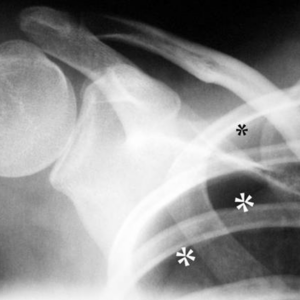####Breathing; Lung pleura and rib pleura = double pleura (Figures 1 and 2)
The following “image slider” is meant to introduce the topic and our material, sparking interest.
The technical text will follow afterward.
In the book “Marfan Syndrome” there is a good article on pneumothorax by the chairman of the Marfan Society, Y. von Kodolitsch. This topic is illustrated here in more detail with pictures and words.
Breathing is a wonderful mechanism. The lungs can ‘take in’ and ‘let out’ air, taking in oxygen and releasing carbon dioxide. Breathing in and out takes place through the nose, mouth, throat, trachea and its fine branches. These airways end in countless air sacs (alveoli).
How do the lungs fill and empty? This is done by expanding and contracting the chest cavity. This can happen in two ways:
By changing the position of the ribs and
by moving the diaphragm.
Fig. 1: Air flows through the nasal or oral cavity into the windpipe; from there, through the branching bronchi into both lungs. The lungs (right and left) are covered by a membrane, the pleura (black boundary line).
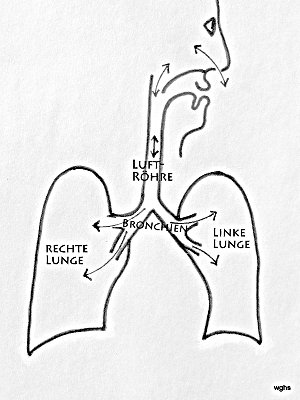
That the lungs are forced to follow the chest cavity obediently is due to the following features:
The lungs are covered by the pleura, and the inside of the chest is lined with the rib pleura. There is no air between these two pleural layers. Therefore, air cannot enter this space, and the pleura covering the lungs is forced to stay in close contact with the rib pleura. Between the two pleurae – also called pleurae (singular: pleura) – there is only a thin film of fluid that helps them move smoothly against each other.
So when we expand the volume of the chest cavity, the lungs must follow and allow air to flow into them. Similarly, when the chest cavity contracts, the lungs must follow and let air out.
The thorax is the entire chest, which includes: the thoracic spine, thoracic wall, upper and lower thoracic openings, and thoracic organs.
The pleura and rib pleura are membranes known internationally as the “pleura.”
Pleura visceralis refers to the lung pleura, and pleura parietalis refers to the rib pleura. The plural form is pleurae.
Fig. 2: The chest cavity is lined on the inside with the “rib pleura”. Between the rib pleura and lung pleura, there is only a narrow gap; it contains no air, at most a thin film of fluid. In this drawing, this gap (or “very tight space”) between the rib pleura and lung pleura is exaggeratedly shown in red for clarity. In the text, this gap is referred to as the “pleural space.”
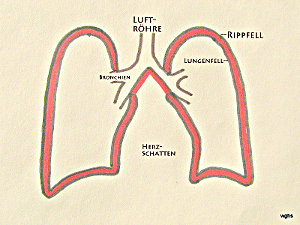
There are two ways to fill the lungs with air. Both can be employed together, making the process even more effective:
1. The diaphragm, the muscular sheet between the chest and abdominal cavities, is arched upwards. When this diaphragm contracts, it flattens and thereby expands the chest cavity (and reduces the abdominal cavity): the lungs must follow this expansion and fill with air.
2. The ribs, attached to the spine, slope downward toward the front. By lifting them, the chest cavity expands. This also forces the lungs to expand and fill with air.
a) How do we manage to inhale?
b) What happens when we tense the abdominal muscles and thereby increase the pressure in the abdominal cavity?
We exhale. However, this only occurs under two conditions:
the diaphragm must be relaxed, and the larynx must allow the airflow.
A foreign object in the airways (“choking”) triggers a reflexive tightening of the abdominal muscles, resulting in a “cough.”
c) What happens when we tense the diaphragm, lift the ribs, and at the same time enclose a tube with our mouth?
We inhale – as described under a) – forcefully.
If the palate separates the nasal cavity from the oral cavity, a vacuum is created in the mouth. This allows, for example, a drink to be sucked in. It is, of course, important to “stop” the process in time, ensuring that the liquid only enters the mouth and not the lungs.
d) What happens when the trumpet player forcefully tightens their abdomen and completely relaxes the rib muscles?
The diaphragm, arching upwards, reduces the thoracic cavity – as described under b); however, this effect is lost because the relaxed ribs allow the thoracic cavity to expand.
For a good trumpet blast to occur, the muscles must stabilize the thorax or even work in the same direction. These types of breathing techniques need to be well practiced, for example, by singers.
Fig. 4: 22-year-old man with known Marfan Syndrome has been complaining of shoulder pain for the past 4 hours.

An accident has not occurred. Which medical specialty is responsible for the patient?
Thick white stars *** mark a white line, the lung pleura. This is normally not visible on an X-ray. Above and to the side of this visible lung pleura is a black space without lung structure; only the ribs overlap this space. This is the pneumothorax, the pleural space expanded into a “space” by air in the wrong place. The pneumothorax is easily recognizable because the lung (below it) is noticeably white. Due to the partial collapse, the lung is denser. Dense means “white” on an X-ray.
(As a side note: The small black star * marks something that is usually difficult to detect: A delicate white line parallel to the rib corresponds to the rib pleura. Here, you can see the faint “bright” line running parallel to the rib; this rib pleura is where it belongs, on the inner boundary of the chest cavity.)
Note: I use the adjective “bright” as it is used in everyday language:”bright” means white!
This is somewhat at odds with the terminology used in radiology, where a black spot on the lung (caused by a pneumothorax, for example) is called a “lucency”.
This linguistic confusion comes from fluoroscopy, where an increase in material, such as a foreign body, was called a shadow, and a decrease in material, such as an air-filled space, was called a lucency.
Diagnosis of Pneumothorax; Main symptom “pain”; Other symptoms; Imaging
What are the symptoms of a pneumothorax? What are the warning signs?
A tear in the pleura is usually felt as pain, but it doesn’t have to be. This is why the diagnosis is not easy.
The patient may not be aware that air has entered the space between the two pleural layers. In any case, the lung cannot expand fully. There is a lack of volume on inhalation, which can be felt and often causes shortness of breath.
Wilcox is more optimistic that “pain” is pointing in the right direction. He found the symptom “pain” in 100% of children with pneumothorax! Shortness of breath occurred in 41% and cough in 6%.
First, “Clinical Examinations” for Diagnosing a Pneumothorax:
Folowed byChest X-ray and/or Ultrasound?
- With careful observation of breathing movements, percussion, and stethoscope examination, suspicion can be strengthened or reduced. Numerous signs of suspicion need to be evaluated quickly.
- Atypical exhalation posture; the affected lung remains unusually inflated.
- Asymmetric breathing movements; the affected lung lags behind.
- Hollow percussion sound (as if tapping on an empty cardboard box: so-called “box sound”). This percussion is always done by comparing sides.
- When listening with a stethoscope, no or very faint breath sounds are heard on the “affected” side.
- A simple but fascinating test I saw years ago in Dundee, Scotland: The greatly increased sound transmission through a pneumothorax. A large coin is placed on the patient’s chest; This coin will be tapped by a second coin. and the chest wall is listened to with a stethoscope at various points.It’s impressive: Where the dampening lung is missing, the pneumothorax transmits sound unusually loudly.
- Subcutaneous emphysema (often with rib fractures and a gap in the rib pleura). With finger pressure on the skin—often on the upper/front thorax, neck, and shoulder—you can feel a looseness that crackles under pressure, like snow, sand, or a collection of Styrofoam pellets. Here, air has escaped from the pleural space and entered under the skin.
The problem with all these signs: They can, but do not have to be present. If they are detectable, they significantly strengthen suspicion. Their absence does not rule anything out.
This pneumothorax “out of the blue” often affects young, slim men between the ages of about 15 and 35. It seems to be caused by the spontaneous rupture of subpleural apical lung blebs. It occurs without any apparent cause, which is why this form is called a spontaneous pneumothorax. The naming is not entirely consistent. Some refer to the pneumothorax, as seen in Marfan syndrome, also as “spontaneous pneumothorax,” although we can assume that the connective tissue weakness present in this syndrome represents a pre-existing condition. In such cases, we should speak of a secondary spontaneous pneumothorax. In this context, other underlying lung diseases should also be mentioned.
Occasionally, it could be caused by the rupture of lung bullae, which may result from smoking or be inherited.
Spontaneous pneumothorax is said to be more frequent during diving and flying at high altitudes. Other diseases that should be mentioned here include: HIV-related Pneumocystis jirovecii infection, cystic fibrosis, or another underlying lung parenchyma disease.
A secondary spontaneous pneumothorax is more serious than a primary spontaneous pneumothorax because it occurs in patients whose underlying lung disease may have already reduced their lung volume.
A rare form of secondary spontaneous pneumothorax occurs in premenopausal (and occasionally postmenopausal) women. It is associated with intrathoracic endometriosis (possibly through the migration of peritoneal endometriosis lesions through diaphragm openings or embolically via pelvic veins).
One must consider a traumatic pneumothorax in all thoracic injuries (especially severe ones), even if they are not penetrating but blunt. In such cases, ribs or the clavicle may fracture, puncture the pleura, and allow air from the lung or aor from outside to enter the pleural space.
The iatrogenic pneumothorax is caused by medical interventions, such as transthoracic fine-needle aspiration, pleural puncture, insertion of a central venous catheter, mechanical ventilation, and cardiopulmonary resuscitation.
One must also consider a pneumothorax in children. Wilcox “collected” 17 children with pneumothorax over 13 years. Interestingly, there was no Marfan patient (or they were not recognized as such). He emphasizes taking children’s complaints of pain very seriously.
Pneumothorax without and with Risk Factors; Complications as Tension Pneumothorax (Figures 5 and 6)
- Bullous lung emphysema (this condition affects the alveoli, often impacting the lung apex).
- Pneumothorax in Marfan syndrome (a congenital connective tissue disorder) is rare. The majority of Marfan patients never experience a pneumothorax. However, there is a predisposition: In 1984, Hull collected 24 publications with case reports and found 11 pneumothoraces among 249 Marfan patients. 7 of the 11 had the recurrence or bilateral pneumothorax described below.
- Pre-existing emphysema blebs are reportedly more common in Marfan patients who suffer a pneumothorax, although such findings may be absent. The reason for the emphysema blebs is believed to be connective tissue instability.
In Marfan patients experiencing chest (or abdominal) pain, one must especially consider aortic dissection! This is a separate and very important topic. Please refer to the “Emergency Situations” section on the Marfan Help website. Despite its significance, one should not forget to also consider pneumothorax, but no time should be lost in doing so.
Overall: Although the connection is loose, pneumothorax should still be considered in Marfan patients. The diagnosis is important because aortic problems are largely preventable, but only through intelligent cooperation between doctors and patients. - Chronic obstructive pulmonary disease (this condition affects the airways, e.g., bronchial asthma unrelated to cigarette smoking). Davies reports on 12 asthma-affected children with pneumothorax, many of whom experienced recurrences. This led the author to recommend early surgery for emphysema blebs.
- COPD, as often seen in smokers (a commonly expected disease).
- Congenital, due to alpha-1 antitrypsin deficiency.
- Violent coughing (particularly harmful when combined with the aforementioned risks, leading to “injuries”).
Fig. 5: Pneumothorax (abbreviated as “Pneu”), no evidence of tension pneumothorax from the overview image (not shown here).

“Tension pneumothorax is a dangerous development of a harmless pneumothorax. It has nothing to do with the causes discussed above. It can develop in any pneumothorax: due to a valve mechanism in the injured visceral pleura and a corresponding (dangerous) increase in pressure in the pleural space. It is a complication of pneumothorax. The diagnostic peculiarities are explained in cases 6 and 7.
Fig. 6: Unremarkable medical history.
Recent history: no accident, sudden pain in the back and left-sided chest area; increasing shortness of breath. This was improved with oxygen administration.
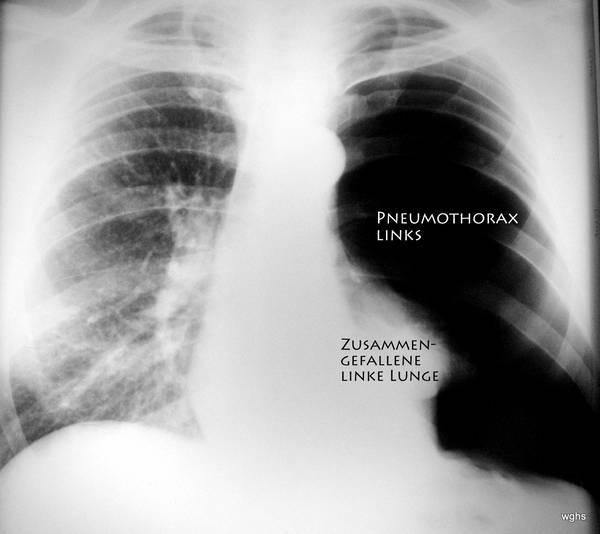
More details on case 6:
Clinical examination (hand, eye and stethoscope):Noticeable asymmetry when listening and tapping the chest.
X-ray: Extensive pneumothorax on the left side (we usually look at the patient from the front).Is it a tension pneumothorax?
Yes. – The displacement of the heart may be underestimated, but the trachea (difficult to see: displaced to the left of the midline of the image) is displaced to the right and – importantly – the diaphragm is flattened and pressed down.
A few minutes later, the pneumothorax was punctured to reduce its volume; (the now atypical, large space between the pleura lining the inside of the chest and the pleura covering the collapsed lung). The puncture was used to insert a soft tube – a drainage tube – into the pleural space. This was done using an old, proven method: a fine, highly flexible wire spiral is advanced beyond the tip of the needle. Given the size of this “pneumo”, puncturing with the needle was easy. Inserting the wire spiral was also unproblematic. The needle is then withdrawn, temporarily maintaining the position of the wire spiral so that the needle cannot cause injury during the subsequent procedure, and the soft drainage tube can be inserted. The tube is passed over the wire spiral, finding its way through all the layers of the chest wall. It unrolls at the tip as the wire is withdrawn. It is so soft that it cannot damage any of the organs in the chest or the pleura. The air in the pneumothorax is now pumped out (a low pressure is created and, most importantly, the increased pressure in the tension pneumothorax is relieved). The two pleurae come back together and the left lung expands again. In most cases, the tear will close and heal on its own. This therapy therefore results in the closure of the leak in the lung pleura. The patient will, of course, remain under observation. The drainage tube can be removed in due course.
The lung did not collapse again in the following months.
Various causes, particularly of traumatic pneumothorax.
- Accident with rib or clavicle fracture. Often occurs in car accidents, motorcycle or horseback riding accidents. A possibly unnoticed bone fragment has pierced the pleural space, injuring the lung pleura.
- Incorrect puncture of the subclavian vein (vena subclavia). This means someone has “punctured” the pleural space, opening it. Air was able to enter the pleural space through the needle.
- Barotrauma: extreme, sudden pressure changes in the lungs during flying or diving.
- Therapeutic pneumothorax: an artificially induced pneumothorax, a treatment used over 60 years ago for pulmonary tuberculosis (see also sections 05-07).
Advice on confirming the diagnosis?
These conditions are treatable, but first, you need to make the correct diagnosis. This is not always easy.
Which method should be used (assuming the patient has been thoroughly examined)? There is a suitable answer to this question: you should use the method with which you have the most experience, and it must be quickly available.
Ultrasound is fast, reliable, and may be more sensitive than an X-ray for detecting a small pneumothorax (mantle pneumothorax). When starting to use ultrasound for pneumothorax, one might initially be disappointed to see seemingly uninteresting images: the air in the pleural space has no sound structure. Like bone, it is a significant obstacle for ultrasound and its reflection. This very characteristic must be leveraged in the sonographic diagnosis of pneumothorax.
There are good educational videos online. It is no shame to recheck the findings, especially when suspecting clinical deterioration.
Chest X-ray: It is generally well-experienced. If there are any deficiencies, the pneumothorax diagnosis can be easily practiced (see the websites listed below). The chest X-ray often provides clarity. Some colleagues find a chest image in expiration useful. In this case, the compressed lung appears brighter (denser) and contrasts even more clearly with the dark pneumothorax. In a disputed case, a CT scan may also be considered.
Ultrasound in addition to a chest X-ray also provides useful information before a puncture: Where is the spleen, where is the diaphragm, and how is it moving?
Fig. 7: 45-year-old, rear-end collision. Fractures – especially rib fractures – have not yet been confirmed.
Is there a tension pneumothorax?

Yes!
Extensive tension pneumothorax on the right!
The overview of the chest x-ray is not easy to interpret. First of all, the position of the heart may be misinterpreted: isn’t the heart protruding quite far to the right? No! It is the collapsed right lung that gives the illusion of a large heart that extends to both sides of the body. This is a misconception!
There is clearly a large pneumothorax in the right chest cavity, a region completely devoid of the typical structure of lung vessels. It is possible that the lung pleura is partially adhered to the rib pleura, preventing the right lung from collapsing into a “spherical” lump, but instead adhering to the mediastinum (middle chest cavity). The atelectatic lung has an irregular shape (probably reflecting a longer history of pleural scarring).
The pneumothorax has another peculiarity: a relatively straight border at its lower edge. Probably there is a moderate amount of blood in the pleural space, and because the x-ray was taken in the standing position, a fluid level has formed between the pathological air and the (probably bloody) pleural effusion. In this case, the ultrasound was very helpful; it confirmed the presence of a significant amount of blood that moved with body position. Most of this blood was removed during the subsequent therapeutic procedure.
It is therefore important to correctly assess the dangerous shift of the heart and mediastinum to the left, both in terms of size and significance. Immediate therapeutic intervention is required.
A few minutes later, the pneumothorax was punctured and the pressure was successfully relieved with a drainage tube.It was a relief for the patient.The suction on the drain was gradually reduced over three days and the lung remained well expanded; the drain was then removed.
Summary of pneumothorax treatment:
Treatment involves removing the air between the two layers of the pleura. The air in the pleural space is in the wrong place and poses a significant danger. Understandably, this air needs to be removed so that it can no longer compress the lungs and threaten vital functions. Only a small pneumothorax can be observed to see if it resolves spontaneously.
This relief is provided by a drainage tube. This is a plastic tube through which the air is sucked out until the hole through which the air entered the pleural space is closed. This drainage requires a puncture; puncturing the pleura would be painful (but it’s the only painful part of the whole therapy). This point is carefully numbed locally for this procedure.
The plastic tube can be very thin, especially if only air is to be removed. If fluid or blood is involved, it is more difficult. A larger tube will then be needed.
The doctor will explain what is being done and why. The question arises: Can the sharp tip of the needle injure something, especially if an organ like the diaphragm moves back and forth when you breathe? This should not happen if the procedure is well planned. Ideally, the two pleural layers should be well separated at the puncture site: the rib pleura will be pierced at such a site, but the lung pleura will not be reached or scratched. Many doctors have their little tricks.
A classic puncture site is below the middle of the clavicle in the second or third intercostal space, with the needle pointing upwards and sideways.
In the case of rib fractures or haemothorax (blood in the pleural space), the puncture is more difficult. A puncture site is needed that can effectively reach and drain these fluids (blood, effusion). In this case, the mid to posterior axillary line at the level of the lower edge of the scapula (5th to 6th intercostal space) is suitable.
Overall, the diagnosis of pneumothorax is not easy. This is partly because it is not a common diagnosis, which requires knowledge of the problem and attention. Treatment has a good chance of success.
The outlook is good.
References
Kodolitsch von, Y., M. Rybczynski: Pneumothorax in Marfan Syndrome, Marfan Hilfe e.V. Steinkopff 2007
Lung Physicians Online – Pneumothorax. German Society for Pulmonology and Respiratory Medicine (DGP), Federal Association of Pulmonologists e.V. (BdP), retrieved on January 25, 2013.
Matthys, H., Seeger, W.: Clinical Pneumology. Springer, Heidelberg 2008, ISBN 3-540-37682-8, p. 581.
Tschopp JM, Rami-Porta R, Noppen M, Astoul P: Management of spontaneous pneumothorax: state of the art. Eur Respir J. 2006 Sep;28(3):637-50. Review. PMID 16946095
Noppen M, Baumann MH: Pathogenesis and treatment of primary spontaneous pneumothorax: an overview. Respiration. 2003 Jul-Aug;70(4):431-8. Review. PMID 14512683
Hall JR, Pyeritz RE, Dudgeon DL, Haller JA Jr. Pneumothorax in the Marfan syndrome: prevalence and therapy. Ann Thorac Surg. 1984 Jun;37(6):500-4
Nishida M, Maebeya S, Naitoh Y. A case of bilateral pneumothorax in the patient with Marfan syndrome. Kyobu Geka. 1996 Jul;49(7):591-4
Wilcox, D.T. et al: Spontaneous pneumothorax: A single-institution, 12-year experience in patients under 16 years of age. J of Pediatr. Surg. 30 (Oct 1995) 1452-54
Davis, A.M. et al.: Spontaneous pneumothorax in pediatric patients. J Ped Surg 29 (Sept 1994) 1183-85 ##
